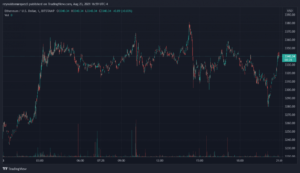
Though generalist tech press have moved on to other shiny objects, Pokémon Go is at the height of its popularity and continues to break records. The latest figures from Sensor Tower estimate* that the game has made $5 billion in lifetime revenue as it passes its fifth birthday.
Zeroing in on 2021, Pokémon Go has already reached $642 million in the first half of the year. This is 34 percent greater than 2020 on a year-over-year basis, and puts it on a $1.3 billion annual run rate. Its FY 2021 outcome will likely be closer to $1.7 billion given its revenue growth pace.
Panning back, our research arm ARtillery Intelligence projects aggregate mobile AR in-app-purchases (IAP) at $1.9 billion in 2021. This aligns with the above $1.7 billion estimate, given Niantic’s dominant market share. Mobile AR IAP is projected to reach $2.57 billion in 2022.
Part of that trendline (without the full-year projections) can be seen in Sensor Tower’s chart below. Pokémon Go’s lifetime revenue is also notable — again an estimated $5 billion — making it by far the biggest consumer AR commercial success in terms of user/player spending.**
One of the remarkable things about Pokémon Go growth and its sustained play over five years, is that the above recent record-setting period in 2020 and ’21 coincided with a pandemic. Indeed, global lockdowns and shelter-in-place orientation don’t align with the game’s migratory play.
Here we’ll credit Niantic’s ingenuity to pivot quickly and adjust game mechanics to accommodate distanced play (though it may have tried to roll back those changes too soon). The result: instead of usage declines, it was able to ride the wave of gaming’s broader COVID-era inflections.
This move fits the profile for Niantic and its ability to achieve $5 billion in lifetime revenue. Not only has it defied odds this year and last, but in a broader sense. It’s rare for mobile games to sustain active play for several years, due to challenges in maintaining novelty and game mechanics.
As we examined in a recent report, Niantic has accomplished this through timely in-game updates, well-devised game mechanics, and underlying design principles that shoot for the right targets. That includes product philosophies like using AR sparingly as a feature.
1. How VR could bring transhumanism to the masses
2. How Augmented Reality (AR) is Reshaping the Food Service Industry
3. ExpiCulture — Developing an Original World-Traveling VR Experience
Beyond product innovation, Niantic’s revenue milestone validates business-model innovation. In-app-purchases (IAP) are a fitting revenue structure, given the behavioral economics of microtransactions. In a broader sense, the model drives $70 billion annually in mobile gaming.
Not only is IAP validated in mobile gaming, but it’s fitting to AR’s early stage when users hesitate to pay upfront for apps. IAP is also supported by consumer survey data from ARtillery Intelligence and its survey partner Thrive Analytics. 30 percent of new/non-AR users are open to IAP.
Niantic meanwhile continues to diversify its revenue model. Though IAP has treated it well, Niantic’s true fate could be as an AR enabler. It’s Lightship platform rolls up the architecture and learnings from Pokemon Go and productizes it as a platform for geolocal AR experiences.
This is both a revenue diversification move, and a more sustainable — almost SaaS-like — model. It also bets on geolocal AR as a leading app category. That’s everything from gaming to commerce and local discovery. In the end, we may know Niantic more for Lightship than Pokémon Go.
This isn’t first-party data from Niantic, but Sensor Tower’s extrapolated figures (and our run-rate calculation). **There’s debate over whether or not Pokemon GO, and thus its associated revenue, should be considered “AR.” We address those questions separately here.
- 2020
- 2021
- 7
- 9
- active
- Annually
- app
- apps
- AR
- architecture
- ARM
- Augmented Reality
- augmented reality (ar)
- Biggest
- Billion
- cases
- closer
- Commerce
- commercial
- consumer
- continues
- credit
- data
- debate
- Design
- discovery
- diversification
- Early
- early stage
- Economics
- Enterprise
- Enterprise AR
- EU
- EV
- Experiences
- EY
- Feature
- First
- follow
- food
- food service
- game
- Games
- gaming
- Global
- Growth
- GV
- How
- HP
- hr
- HTTPS
- ia
- Innovation
- Insider
- Intelligence
- IT
- latest
- leading
- local
- lockdowns
- Making
- mark
- Market
- medium
- million
- Mobile
- Mobile games
- Mobile gaming
- model
- move
- Niantic
- open
- Other
- pandemic
- partner
- Pay
- platform
- pokemon
- press
- Product
- Product Innovation
- Profile
- Reality
- records
- research
- revenue
- rolls
- Run
- sense
- Share
- Spending
- Stage
- success
- Supported
- Survey
- sustainable
- tech
- Updates
- users
- vr
- Wave
- year
- years








